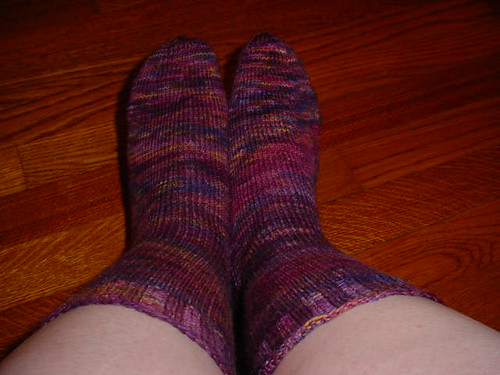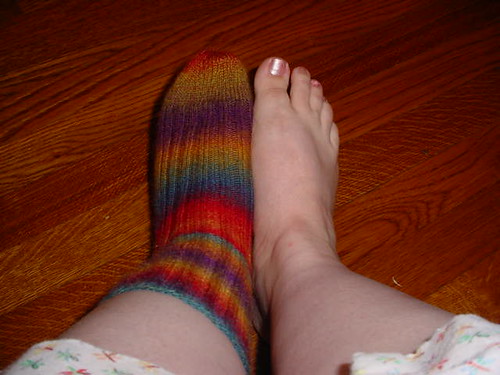I always liked that show. Part of it was (of course) the fact that it was a show about making stuff, about the knowledge and skill surrounding making furniture and doors and toys and other objects of wood.
I think I also liked it because it had kind of a loose, "homespun" feel about it - the Wikipedia page claims it's filmed in one take, and I think that while I didn't figure that out specifically, I could sense that the show was more free-form than some of the more tightly-done shows (like cooking shows - as much as I love them, some of them feel too much like there are lots of "elves" scurrying around behind the scenes doing the mise-en-place and pre-chopping stuff and cleaning up the messes, so you don't get quite the same sense as you would if you were trying to replicate the recipe in your own kitchen).
And I'm also happy that I learned something yet again from this morning's episode: why things were chamfered. (that's where the edge of a beam is cut off at a 45 degree angle. I always thought it was purely decorative but according to Underhill, it was done on wagons and such to reduce the weight of the wood while still keeping most of the strength).
I also liked the show, I think, because the host seemed a bit of a non-comformist - not *quite* a hippie, but he definitely dressed differently than most folks I knew, but his clothes were chosen, it seemed, for practicality in his work.
(He also has a good Arts-and-Crafts name, almost a Hobbitish name: Roy Underhill.)
He had a Welsh chairmaker on this morning (I came in a little late to the start, as I said, I had been flipping around different channels). They were looking at old tools and a replica of a 1000 year old Viking toolbox. And they were talking about how the ancient tools still worked just fine for the handwork sort of applications, and Underhill made a comment as to why:
"Wood is wood and iron is iron."
Meaning, things like that don't change their properties over time.
And you know, I think that's part of the reason why I like the traditional crafts, summed up right there. Once you learn the properties of something, once you learn how it works, you're always going to have those skills. The knit stitch I learned how to make at 10 still works just fine 30 odd years later. The handsewing I learned to do at 6 - well, I still pretty much do it the same way (the stitches may have gotten smaller and more even over the years as I grew in patience and skill).
And also, the tools are much the same. The actions are the same. When I sit down to quilt, it is something my grandmother would recognize - something my great grandmother, and very possibly my great-great grandmother would recognize as something they had done. And with knitting - well, it goes back to AT LEAST 1400 in Europe (where all of my ancestors, at least the "recent" in the sense of last-few-millennia, hail from). So even very far back ancestors would recognize the motion and the shape of the tools (if not the material they are made from - right now I'm working with plastic needles for one thing.
I like that sense of constancy, and that sense of shaking hands with the past. And the idea that in a changing world, there are at least a few things you can cling to that remain the same.
And I find that comforting. I often talk on here about how people baffle me sometimes, how I have a hard time dealing with certain human behavior. I expect people to be logical and somewhat predictable but they often are not. For example, I have a hard time talking with someone who is angry, even when (perhaps especially when) that anger is not directed at me. I know someone who periodically is prone to bouts of "free floating" anger, where he gets kind of snappish and churlish and even when I try to be as mild and calm as I can be, he may still wind up "going off" on me for something that would, were he in a better mood, not even be noticed.
So it's a relief to come home to the quilt in the frame. Or the sweater I'm knitting on. Or a batch of bread dough. Because I can kind of count on how they will behave.
(I'm also reminded of the old line from Prince Caspian, which I remember loving when I was a child:
"I'm a beast, I am, and a Badger what's more. We don't change. We hold on."
I loved Trufflehunter for his loyalty.)
One thing I've also realized is that I am, by and large, a low-tech sort of person. Oh, I use technology every day at work, and I openly admit that I love the Internet. But when it comes to "gadgets" for entertainment...I never got into video games much. I don't own a fancy cell phone. I'm a little bewildered at the popularity of texting someone (even someone in the same room, as I've seen happen among groups of teens). I used to think it was because I was a bit older - video games didn't become extremely common (at least, as an item in the home) until I was a tween or teen, and cell phones really only became widespread once I was in grad school (and I didn't have one until I was out on my own and working...)
But I don't think it's just a matter of age - people older than I am get really interested in these things. I think it's actually family influence: my parents were, by and large, pretty low-tech when my brother and I were growing up. We didn't get cable - even though it was available before - until 1986 or so, and it was only a few years ago that they got a dvd player. And while we had computers fairly early on (I fondly remember the TI-99/4A we had), they weren't a major part of our entertainment life. (I did learn to play chess on that computer. And program it to do things like have "goto" loops so it would say something like "booger" over and over and over again. Which I thought was hilarious when I was 12.)
And we also had PONG fairly early on, but I remember getting bored with that fast.
So I don't know if there's some kind of genetic component that makes someone more interested in the sort of traditional handworks thing, or if it's something learned - certainly, as I said before, my parents were big on doing their own repairs and also on "making stuff."
But shows like "Woodwright's Shop" make me happy, even if I would never have the space or the tools (or the time to learn the skills necessary) to build my own chairs and bookshelves. It's still fun to watch Roy Underhill having fun (and he must be, else he would not continue the show for some 30 years) doing it.
****
My knitting mojo is returning. First off: a pair of simple socks that I completed over break and never posted here:

These are just simple, 64-stitch socks, made using a hand-dyed yarn. (Beyond Basic Knits' "Le Jardin" - it actually looks more like "Le Vignoble" (the vineyard) to me). I like the color and would probably be a lot more excited about them if it were cool enough right now to consider wearing wool socks.
Also, this morning, I finished a long-stalled project: the first of a pair of socks knit of Mini Mochi.

Mini Mochi is a very pretty yarn but it is not fun to knit with because it is a bit loosely spun and has a slight "halo," which means you have to be careful not to split stitches.
Again, these were what I term "simple" socks - in this case, they are just ribbed. Which sometimes makes them more tedious to knit, though better to knit on "autopilot."
You also might notice that I re-did my toenail polish. This time I used a "base coat" and a "top coat" (essentially clear nail polish) in the hopes of keeping it from chipping. (The polish on my fingers is LONG gone, and as I'm going to be working with lots of soil in the coming weeks I don't think I'll be putting any more on, because any kind of heavy-duty research work wrecks a manicure pretty fast).
The color is different - I bought a new one when I bought the clear coat. It's called "Profound Pink," which makes me laugh a bit.
Because it's definitely not "profound" in the color sense, like the French poet who said something like the "profound immensity of blue" when describing the sky (or maybe the ocean, I forget), because this is definitely a paler pink.
And it's surely not "profound" in the philosophical sense. I can't imagine anything profound about painting one's toenails. (Then again, I'm a biologist, not a semiotician, and it's entirely possible that someone somewhere has written a treatise on what polished toenails mean, including what it means when you don't also do the fingernails AND when you opt to do it yourself, rather than going to one of those Happy Pretty Nail Fun places where they do it for you).
But I do rather like the color. It's pearlized, and has the effect of at some angles making it look like the nails are not polished at all, whereas at other angles, you can definitely see the shiny pink.
1 comment:
Meaning of nail paint, heh. The botany department field trip which I've repeatedly talked about on Rav and which is going to amaze me for quite a while yet... well, I had painted toenails and the folks seemed to be amazed by such vanity, including gals who started the day with eyeliner, mascara and face paint. When people looked at my feet surprised, I said I've lived at the Arts Faculty for too long. Or maybe the actual meaning is 42.
Post a Comment